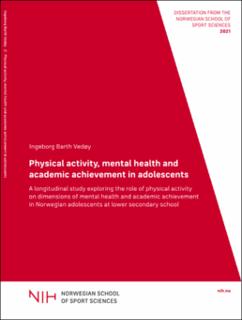| dc.contributor.author | Vedøy, Ingeborg Barth | |
| dc.date.accessioned | 2021-12-14T07:50:42Z | |
| dc.date.available | 2021-12-14T07:50:42Z | |
| dc.date.issued | 2021 | |
| dc.identifier.isbn | 978-82-502-0596-3 | |
| dc.identifier.uri | https://hdl.handle.net/11250/2834074 | |
| dc.description | Avhandling (doktorgrad) - Norges idrettshøgskole, 2021 | en_US |
| dc.description.abstract | Introduction: Good mental health during adolescence is seen as important for positive social and educational outcomes, as well as a healthy transition to adulthood. Similarly, achieving academic success at school is associated with later educational success, higher income and better physical and mental health. Mental health and academic achievement during adolescence thus serve as important determinants of future health and wellbeing. Consequently, it is important to explore factors that may promote mental health and academic achievement during adolescence. Physical activity (PA) has been identified as a factor that may promote both mental health and academic achievement among young people. Nevertheless, research in this field to date has been replete with methodological issues related to measurement of PA, mental health and academic achievement as well as primarily reliant on cross-sectional study designs.
Purpose: The overall purpose of this thesis was to explore the cross-sectional and longitudinal relationships between objectively measured PA and mental health (both in terms of mental health problems and mental well-being) and objectively measured PA and academic achievement among Norwegian adolescents.
Methods: This thesis is based on a three-year prospective cohort study of 599 lower secondary school students (aged 12 to 16 years) recruited from 11 schools in the east and west side of Norway. Mental health was assessed by the Strengths and Difficulties Questionnaire, the Warwick-Edinburgh Mental Well-Being Scale and the Self-Perception Profile for adolescents. Academic achievement was measured by grade point average from midterm grades and PA was measured objectively using accelerometers over a period of 7 days. Data were collected annually from 2016 to 2018.
Main results: Paper I found small cross-sectional associations between PA and mental wellbeing, as well as with domain-specific self-esteem. There was no association between PA and mental health problems or academic achievement. Paper II found no longitudinal relationship between change in volume or intensity of PA and academic achievement, neither through direct nor indirect associations. Paper III found a longitudinal relationship between increase in sedentary time and higher levels of mental wellbeing among boys, as well as a small relationship between increase in PA volume and mental wellbeing in girls. No relationships were present for change in sedentary time, volume or intensity of PA and mental health problems.
Conclusion: Overall, the results point towards no clear relationship between either PA or sedentary behaviour and mental health problems. As stronger associations between PA and indicators of mental health is found in clinical samples, these results may suggest that the relationship is less clear among an apparently healthy study sample. With regard to the positive dimensions of mental health, Summary results showed small associations between PA and domain-specific self-esteem, as well as with mental wellbeing, especially for girls. Based on the positive relationship between sedentary behaviour and mental wellbeing among boys, there is a need to further explore whether this relationship varies with different activities when sedentary. No evidence of a relationship between PA and academic achievement was found, and thus suggest them to be largely unrelated in the current study sample. These results provide some weight to the possibility that PA may relate differently to diverse indicators of mental health, and that the determinants of mental health problems and how well adolescents do at school may lie beyond the amount and intensity of PA. | en_US |
| dc.language.iso | eng | en_US |
| dc.relation.haspart | Paper I: Barth Vedøy, I., Anderssen, S. A., Tjomsland, H. E., Skulberg, K. R., & Thurston, M. (2020). Physical
activity, mental health and academic achievement: a cross-sectional study of Norwegian adolescents. Mental Health and Physical Activity, 18, 100322. doi:10.1016/j.mhpa.2020.100322 | |
| dc.relation.haspart | Paper II: Barth Vedøy, I., Skulberg, K. R., Anderssen, S. A., Tjomsland, H. E., & Thurston, M. (2021). Physical activity and academic achievement among Norwegian adolescents: Findings from a longitudinal study. Prev Med Rep, 21, 101312-101312. doi:10.1016/j.pmedr.2021.101312 | |
| dc.relation.haspart | Paper III: Barth Vedøy, I., Skulberg, K. R., Anderssen, S. A., Fagerland, M. W., Tjomsland, H. E., & Thurston, M.
(2021). The longitudinal association between objectively measured physical activity and mental health among Norwegian adolescents. Status: Currently being revised after reviewers’ feedback with Int J Behav Nutr Phys Act. | |
| dc.subject | nih | en_US |
| dc.subject | doktoravhandlinger | en_US |
| dc.subject | nih | en_US |
| dc.title | Physical activity, mental health and academic achievement in adolescents : A longitudinal study exploring the role of physical activity on dimensions of mental health and academic achievement in Norwegian adolescents at lower secondary school | en_US |
| dc.type | Doctoral thesis | en_US |
| dc.description.version | publishedVersion | en_US |
| dc.description.localcode | Institutt for idrettsmedisinske fag / Department of Sports Medicine | en_US |
